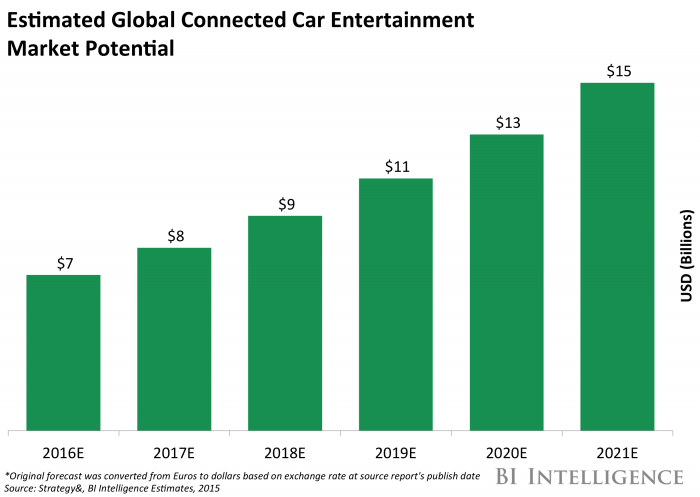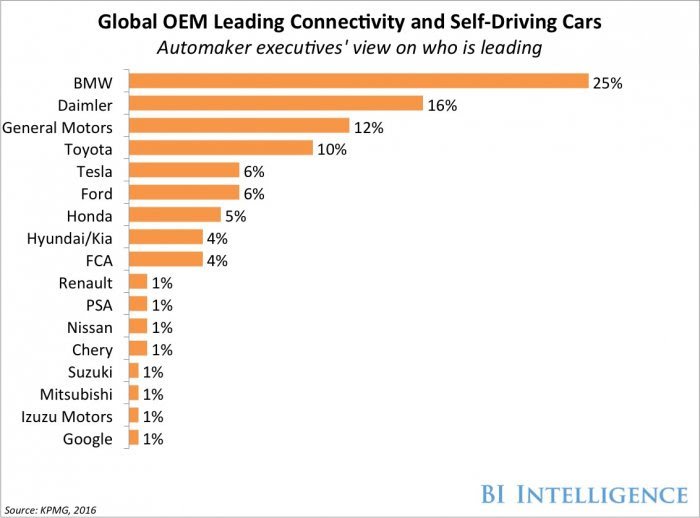Thats why BI Intelligence has spent months compiling the greatest and most detailed collection on the IoT:The Internet of Things: Examining How The IoT Will Affect The World.
So which automotive companies are leading the pack in this connected car push? There is no clear winner, but several companies are setting the tone. BMW is the champion, according to a KPMG survey of 200 automotive executives. Daimler, General Motors, Toyota, and Tesla are also near the top of the list.
Furthermore, app integration is becoming commonplace in todays vehicles. Google Maps and other navigation tools have begun to replace built-in GPS systems. Apps such as GasBuddy show the driver where he or she can find the cheapest fuel in their area. Music apps such as Spotify remove the need for traditional or even satellite radio.
Second, automotive companies can use data from the car to analyze its performance and obtain valuable data on how drivers use their cars. Finally, more connectivity provides more ways for automakers to cross-sell their products and services to customers.
Consumer interest in the connected car is growing, and that will rapidly translate into dollars. Approximately 62% of U.S. consumers were aware of the term connected car in a recent AT&T and Ericsson survey. And Google Trends shows the term connected car is reaching new highs every month. As a result, estimates say in-car infotainment centers will generate $15 billion in sales in 2021, up from $7 billion in 2016.
But it wont just be car wi-fi that changes the automotive industry. Public transportation, such as buses and trains, will also transform thanks to the IoT. Subway cars in New York City, for example, will start to have chargers, built-in Wi-Fi, and security cameras, according to the citys Metropolitan Transportation Authority.
Subscribe to an ALL-ACCESS Membership with BI Intelligence and gain immediate access to this report AND over 100 other expertly researched deep-dive reports, subscriptions to all of our daily newsletters, and much more.
* Copyright © 2018 Insider Inc. All rights reserved.
The Internet of Things will become increasingly important in transportation andlogisticsin the next several years, especially as self-driving cars hit the road in increasing numbers. But this is just one area that the IoT will totally transform.
Automakers are ramping up their connected car efforts for several reasons. Internet connectivity in vehicles allows car companies to release software updates in real time, which is extremely important during a recall.
To get your copy of this invaluable guide to the IoT universe, choose one of these options:
Purchase the report and download it immediately from our research store.
In the last several years, connected cars have exploded thanks to the IoT. Currently, automakers are connecting their vehicles in two ways: embedded and tethered. Embedded cars use a built-in antenna and chipset, while tethered connections use hardware to allow drivers to connect to their cars via their smartphones.
The government is also cracking down on texting while driving, a problem that connected cars would solve by letting drivers keep their hands on the wheel and their eyes on the road even as they communicate with others.
Registration on or use of this site constitutes acceptance of ourTerms of ServicePrivacy Policy, andCookies Policy.
Speaking of self-driving cars, BI Intelligence expects this to be the next wave of innovation in the IoT in transportation. And that change has already begun.
As far as tech companies, AT&T is a prime example. The telecommunications giant added 2.7 million connected cars in the U.S. in the first three quarters of 2015. But Microsoft, Apple, Pandora, Sprint, Google, and other tech heavyweights are all throwing their considerable muscle behind connected cars.
Companies are pouring money into the Internet…
Companies are pouring money into the Internet of Things, and one area of particular interest to investors is IoT connected cars.
Automakers have correctly noticed a growing trend and a significantbusiness opportunityfor connecting their cars. BI Intelligence expects 381 million connected cars to be on the road by 2020, up from 36 million in 2015. Furthermore, BI Intelligence forecasts that connected cars will generate $8.1 trillion between 2015 and 2020.
Now, were starting to get into the truly exciting stage. Step four is cars that require a driver behind the wheel, but have an option for the driver to push a button to let the car drive itself. Step five will be totally driverless vehicles that do not require a driver behind the wheel, or even a steering wheel at all. BI Intelligence expects these cars to hit the market after 2020.
Step one was stop and go autopilot, which allows cars to drive themselves in traffic jams by analyzing the lane ahead of them and moving appropriately. Step two was the remote valet assistant, the ability to actually summon a car in a small space (such as a parking garage) through a smartphone, smartwatch, or key fob. Step three was highway autopilot with lane changing, which included blind spot technology to shift lanes.
Still, connected cars will be the bread and butter of the Internet of Things automotive industry. Below, weve compiled a history of the growth of theIoT in transportationand outlined how the Internet of vehicles will surge in the coming years.

The choice is yours. But however you decide to acquire this report, youve given yourself a powerful advantage in your understanding of the fast-moving world of the IoT.
BI Intelligence, Business Insiders premium research service, expects 94 million connected cars to ship in 2021, and for 82% of all cars shipped in that year to be connected. This would represent a compound annual growth rate of 35% from 21 million connected cars in 2016.
But the true driver conveniences started rolling in after that. Compact disc players started popping up in cars in 1985, followed by dashboard computer diagnostics in 1994 and GPS navigation systems in 1995. Then, in the 2000s, cars started to feature USB ports and Bluetooth connectivity, the later of which was the true precursor to the connected cars of today.
And all of this effort will not go unnoticed or unappreciated by consumers. A recent Google survey found that 30% of U.S. smartphone users get anxious without their smartphone on them, and 68% check their smartphones within 15 minutes after waking up in the morning. Connected cars allow people to stay connected more frequently and remove that anxiety.

Perhaps the most significant example of the transformation of the automobile today is part two of Teslas master plan, as outlined by CEO Elon Musk. The electric car giant plans to create solar roofs with integrated battery storage, create self-driving car technology that is ten times safer than manual driving, and implement car sharing, which would allow Tesla owners to earn money by lending out their cars.
The first true technological leap forward for cars came in 1911, when automobile companies began installing electric starters into vehicles, according to Mashable. The cigarette lighter arrived in 1925, the radio in 1930, power steering in 1956, the 9-track player in 1965, the cassette deck in 1970, and air bags in 1984.
